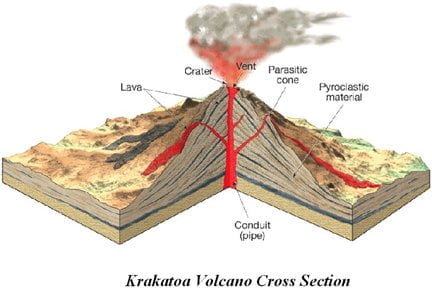
“On the afternoon of the 26th there were violent explosions at Krakatoa, which were heard as far as Batavia.
High waves first retreated, and then rolled upon both sides of the strait.
During a night of pitchy darkness these horrors continued with increasing violence,
augmented at midnight by electrical phenomena on a terrifying scale.”
By E. W. Sturdy
ttps://www.theatlantic.com/magazine/archive/1884/09/the-volcanic-eruption-of-krakatoa/376174/
Krakatoa, was an island in the Strait of Sunda, sort of halfway between Java and Sumatra, they think it was created as the result of a volcanic eruption sometime in the fifth or sixth century.
It occurred after months of mini eruptions, when it threw out clouds of dust, which had been regularly reported by ships traveling through the straits, then finally, on August 27th 1883 Krakatoa exploded!
What an explosion it was!
It is said that it was the most powerful volcanic eruption ever recorded in history, even greater that when Vesuvius erupted. However, we don’t know that for sure as in Roman times they didn’t have any recording instruments to tell us how powerful it really was.
Fortunately, Krakatoa was an uninhibited island, so everybody thought they were safe, yes that’s what they thought!
They were wrong.
Unfortunately, it was the start of a series explosions, with each one being more powerful than the previous that lasted for 24 hours. It resulted in a gigantic blast throwing the ash as far as 50 miles in the air, and a sound that was heard in Perth,Australia
As a result, tens of thousands drowned as a result of the tsunamis developed when the volcano collapsed into the caldera.
This was the large depression that formed when Krakatoa erupted and then collapsed. You see during a volcanic eruption, the magma in the chamber underneath the volcano is ejected forcefully. Then what happens is that the chamber empties, with the result with the magna gone, there is no support inside the chamber. The result is that the sides and the roof of the Volcano to collapse inward, and it is this that caused an enormous tsami.
The effect
It threw five cubic miles of earth 50 miles into the air, it created a 120-foot tsunami that led to a 120-foot-high wall of water forming that wiped out 165 coastal villages on Java and Sumatra.
According to the official records of the Dutch East Indies colony, 165 villages and towns were destroyed near Krakatoa, and 132 were seriously damaged. At least 36,417 people died, and many more thousands were injured, mostly from the tsunamis that followed the explosion. The eruption destroyed two-thirds of the island of Krakatoa.
As evidence of the tsunami’s devastating power, water deposited the steamship Berouw nearly a mile inland on Sumatra, killing all its crew members.
Isn’t history interesting?
10 questions to discuss:
- What factors leading up to the August 27th, 1883 eruption hinted at the impending disaster?
- Despite its remote location, how did the eruption’s immense power still impact distant regions?
- Why are tsunamis a particularly dangerous consequence of volcanic caldera collapses?
- How do the estimated death tolls from the Krakatoa eruption compare to other major volcanic disasters?
- Beyond the immediate devastation, what were the long-term environmental and social impacts of the eruption?
- What scientific advancements in disaster monitoring and prediction have been made since the Krakatoa eruption?
- How did the event highlight the importance of early warning systems and evacuation planning for volcanic hazards?
- Can we use the learnings from Krakatoa to predict or prepare for future volcanic eruptions in populated areas?
- Does the story of Krakatoa offer any insights into the relationship between humanity and powerful natural forces?
- How can historical disasters like Krakatoa influence our understanding and responses to contemporary environmental challenges?
These questions are to encourage deeper understanding by:
- Examining the eruption’s context and build-up.
- Analysing the immediate and long-term consequences.
- Exploring advancements in disaster prediction and preparedness.
- Connecting the event to broader themes of human-environment interaction and risk management.
To learn more, go to:

